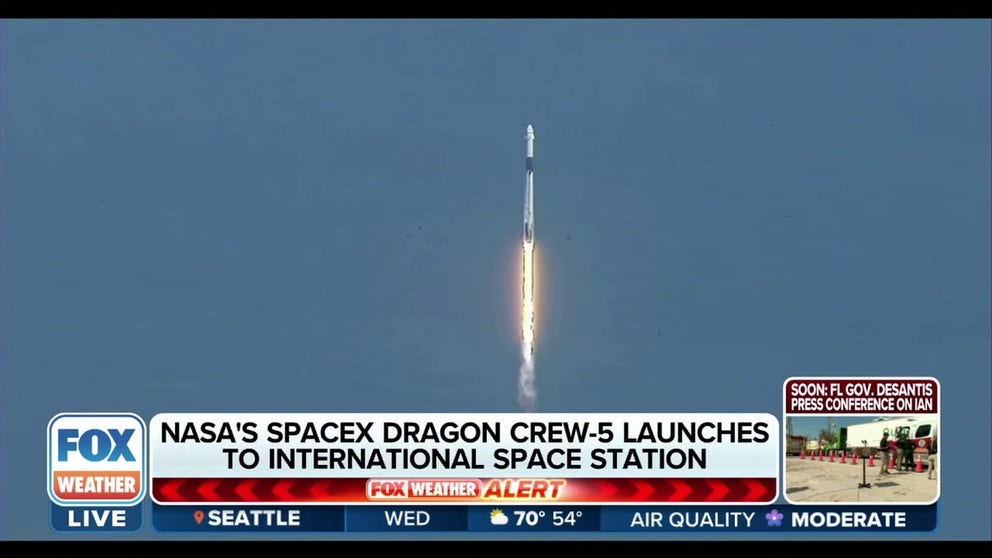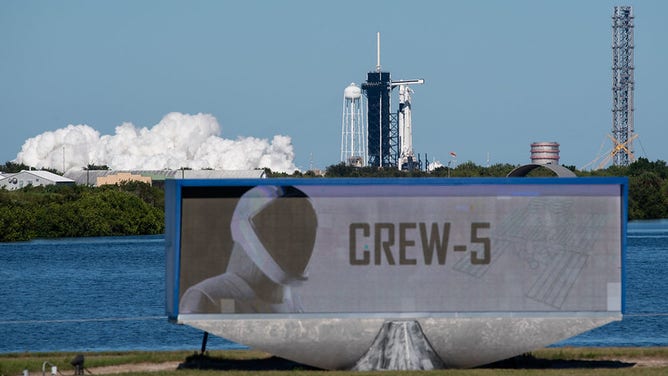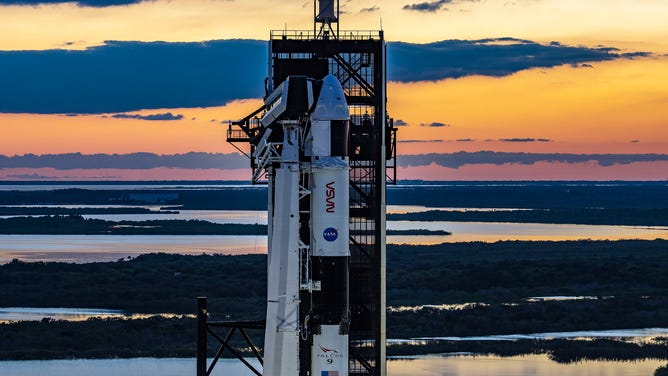Liftoff! SpaceX launches NASA, Japanese, Russian astronaut crew from Florida
NASA astronauts Nicole Mann and Josh Cassada, JAXA astronaut Koichi Wakata and Roscosmos cosmonaut Anna Kikina will arrive at the space station after a 29-hour spaceflight.
NASA's SpaceX Crew-5 launches to the ISS
NASA's SpaceX Crew-5 mission siccessfully launched to the International Space Station. Homer Hickam, Best-selling author, subject of the movie October Sky, and retired NASA engineer, dicusses what this means for NASA.
KENNEDY SPACE CENTER, Fla. – Four astronauts from three countries launched on Wednesday with SpaceX on a six-month mission to the International Space Station.
The Falcon 9 rocket and Crew Dragon launched at noon from Kennedy Space Center launchpad 39A, sending two NASA astronauts, a Russian cosmonaut and a Japanese Space Agency (JAXA) astronaut.
The Crew-5 mission, the fifth for SpaceX as part of NASA's Commercial Crew Program, was delayed by Hurricane Ian, which made landfall on the Southwest Florida Gulf Coast as a Category 4 storm last week.
HOW TO WATCH FOX WEATHER ON TV
After a 29-hour spaceflight, SpaceX's Crew Dragon Endurance capsule will dock at the space station with Mission Commander Nicole Mann and Pilot Josh Cassada, JAXA astronaut Koichi Wakata and Roscosmos cosmonaut Anna Kikina.
NASA began live coverage of countdown activities Wednesday morning with astronaut Bob Behnken joining NASA host Derrol Nail for commentary on the launch. Behnken launched on SpaceX's Demo-2 test flight to the ISS in 2020 along with NASA astronaut Doug Hurley, marking the first astronaut launch from Florida since 2011.
After an early wakeup call and breakfast, the astronauts suited up in the KSC Operations and Checkout building with the help of SpaceX personnel known as "ninjas" wearing all black.
Next, the Crew-5 team walked outside and had a few moments to wave goodbye and exchange their final in-person words with family and friends outside the O&C building.
In SpaceX style, Elon Musk's company uses two Teslas to transport the astronauts to launchpad 39A, and the crew members each picked some songs for the ride to the pad.
More than 3 hours before liftoff, all four astronauts were helped into the Crew Dragon Endurance capsule and buckled in for the ride.
A few minor issues popped up as the crew settled in, but the countdown continued as planned.
SpaceX teams double-checked Cassada's suit for leaks and "verified" his zippers after seeing different pressure readings than during the launch practice earlier this week. Then, teams found a piece of hair delaying the spacecraft hatch from closing. SpaceX personnel look for any FOD, or foreign object debris, before closing the Dragon hatch.
The Falcon 9 blasted off at 12:00:50 p.m. ET into a blue sky dotted with clouds.
"That was a smooth ride uphill," Mann exclaimed shortly after launch.
‘Happiest thought’
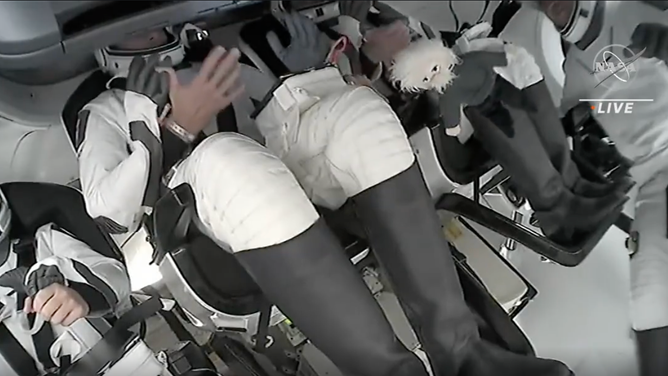
A plush toy "little Einstein" floats about the Crew Dragon capsule after SpaceX launched four astronauts from Kennedy Space Center on Oct. 5, 2022. (Image: NASA/SpaceX)
After reaching orbit, the astronaut-cosmonaut crew revealed a "little Einstein" as the zero-gravity indicator. Astronauts usually bring a plush toy or stuffed animal that floats about the cabin. Previous zero-gravity indicators have included a sparkly dinosaur, a turtle and a monkey, all selected with special meaning for the crew or their families.
The Einstein miniature was a tribute to the German physicist’s "happiest thought."
"While he was sitting in the patent office … he had what he described as the happiest thought of his entire life, that thought was ‘a person in free fall can feel their own weight," Cassada said.
He continued, "we’re experiencing Einstein’s ‘happiest thought’" continuously while in orbit.
Cassada, also a physicist, said Crew-5 is calling the little Einstein its "free fall indicator."
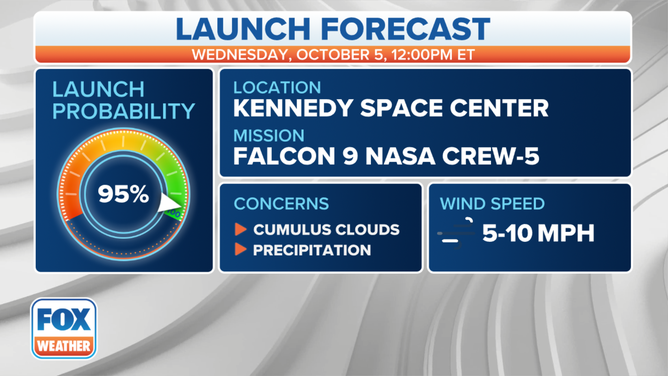
SpaceX, NASA Crew 5 launch forecast for Oct. 5, 2022.
Florida's forecast at KSC called for a beautiful day for liftoff with almost a 100% perfect launch probability, according to the 45th Weather Squadron.
With a dew point around 60 degrees and 50% humidity, the sound from the rocket rumble was muted compared to summer launches with more moisture in the air.
"The weather couldn’t have been better here at Kennedy Space Center. We didn’t even have to look at the (weather) monitor we could just look out the window and see a beautiful blue sky," NASA Commercial Crew Program manager Steve Stitch told reporters after the launch.
About 8 minutes after launch, the SpaceX Falcon 9 first stage returned and landed on a drone ship in the Atlantic Ocean. SpaceX has successfully recovered more than 100 rocket boosters and refly the rockets, sometimes more than 10 times. This was the first flight for this particular booster.
Why this mission is unique
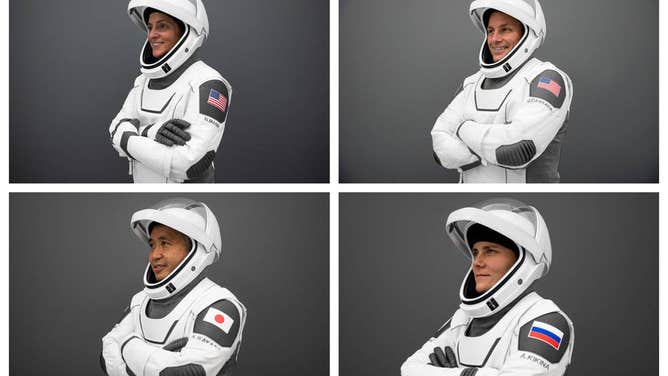
A collage of NASA’s SpaceX Crew-5 from left to right, top to bottom :NASA astronauts Nicole Mann and Josh Cassada, JAXA (Japan Aerospace Exploration Agency) astronaut Koichi Wakata, and Roscosmos cosmonaut Anna Kikina. (Image credits: NASA)
(NASA)
It is the first time in space for all but one of the Crew-5 astronauts. This is the third type of spacecraft for Japan's Koichi. Koichi has spent more than 347 days in space during two Soyuz missions and Space Shuttle Endeavour.
Mann, a member of the Wailacki Tribe, will become the first Native American woman to visit the International Space Station. A dream catcher made by Mann's mother is among the personal items flying with her to the low-Earth orbit. She is also the first female commander of a SpaceX Dragon mission.
Mann and Cassada were both previously assigned to fly on Boeing's Starliner spacecraft, the second spacecraft NASA selected under the commercial crew program to fly astronauts to and from the ISS. After delays with Starliner, NASA reassigned Mann and Cassada to a SpaceX flight. Boeing and NASA are targeting February for the first crewed flight test of Starliner to the space station.
Kikina is the first cosmonaut to fly with SpaceX.
Roscosmos has very few women cosmonauts. In the U.S.S.R., the space agency was the first to send a woman to space. Kikina will be the sixth Russian woman to fly in space overall.
Docking and arrival
The crew will spend more than 24 hours in the spacecraft before docking at the International Space Station at 4:57 p.m. EDT Thursday. The Crew Dragon can autonomously park itself at the ISS docking ring, but as the mission pilot, Cassada can manually take over if needed.
The astronaut-cosmonaut crew will be greeted by the seven astronauts already living on the ISS, including the four Crew-4 astronauts, NASA astronaut Frank Rubio and two Russian cosmonauts.
Wednesday's liftoff marks the second of three rocket launches from Florida's Space Coast this week. ULA launched two communication satellites on Tuesday, and SpaceX plans to launch communication satellites for another customer on Thursday.
